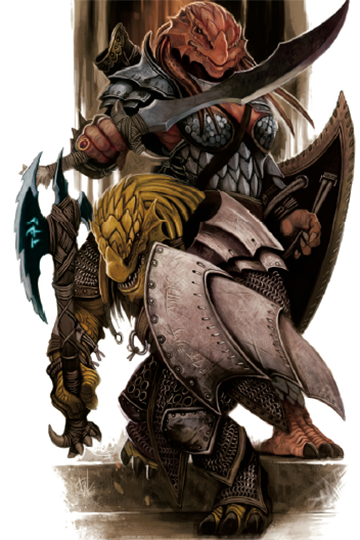Dragonborn
Born to fight, dragonborn are a race of wandering mercenaries, soldiers, and adventurers. Long ago, their empire contended for worldwide dominion, but now only a few rootless clans of these honorable warriors remain to pass on their legends of ancient glory.
Basic Information
Additional Information
Social Structure
Dragonborn owe their devotion and respect to their clan above all else, even the gods. Each dragonborn’s conduct reflects on the honor o f his or her clan, and bringing dishonor to the clan can result in expulsion and exile. Each dragonborn knows his or her station and duties within the clan, and honor demands maintaining the bounds o f that position.
Civilization and Culture
Naming Traditions
Male Names: Arjhan, Balasar, Bharash, Donaar,
Ghesh, Heskan, Kriv, Medrash, Nadarr, Patrin,
Rhogar, Shamash, Shedinn, Torinn
Female Names: Akra, Biri, Daar, Harann, Kava,
Korinn, Mishann, Nala, Perra, Raiann, Sora, Surina,
Thava
Culture and Cultural Heritage
To a dragonborn, honor is more important than life itself. First and foremost, honor is tied to battlefield conduct. Adversaries should be treated with courtesy and respect, even if they are bitter enemies. Caution and discretion are key to a warrior’s survival, but fear is a disease and cowardice is a moral failing. The drive to behave honorably extends into the rest of a dragonborn’s life: Breaking an oath is the height of dishonor, and attention to honesty extends to every word. A commitment made must be carried out. Ultimately, a dragonborn takes responsibility for his or her actions and their consequences.
A continual drive for self-improvement reveals an additional aspect of dragonborn honor. Dragonborn value skill and excellence in all endeavors. They hate to fail, and they push themselves to extreme efforts before they give up on something. A dragonborn holds mastery of a particular skill as a lifetime goal. Members of other races who share the same commitment find it easy to earn the respect of a dragonborn The dragonborn dedication to honor and excellence sometimes leads others to view dragonborn as arrogant and proud. Most dragonborn share a great pride in their race’s past and present accomplishments, but they are also quick to admire the accomplishments of others. Even though the Tiefling empire of Bael Turath was the enemy of the ancient dragonborn empire of Arkhosia, dragonborn recognize Tiefling as worthy companions or opponents, admiring their strength and tenacity as friends or enemies.
Dragonborn seek adventure for the chance to prove their worth, win renown, and perhaps become champions about whom stories will be told for generations. To win everlasting glory through mighty deeds, daring exploits, and supreme skill—that is the dragonborn dream.
Lifespan
75 - 90 years
Average Height
185 - 205 cm
Average Weight
100 - 145 kg
Average Physique
Dragonborn resemble humanoid dragons. They’re covered in scaly hide, but they don’t have tails. They are tall and strongly built, often standing close to 6½ feet in height and weighing 300 pounds or more. Their hands and feet are strong, talonlike claws with three fingers and a thumb on each hand. A dragonborn’s head features a blunt snout, a strong brow, and distinctive frills at the cheek and ear. Behind the brow, a crest of hornlike scales of various lengths resembles thick, ropy hair. Their eyes are shades of red or gold.
A typical dragonborn’s scales can be scarlet, gold, rust, ocher, bronze, or brown. Rarely do an individual’s scales match the hue of a chromatic or metallic dragon, and scale color gives no indication of the type of breath weapon a dragonborn uses. Most dragonborn
have very fine scales over most of their body, giving their skin a leathery texture, with regions of larger scales on the forearms, lower legs and feet, shoulders, and thighs.
Remove these ads. Join the Worldbuilders Guild










Comments